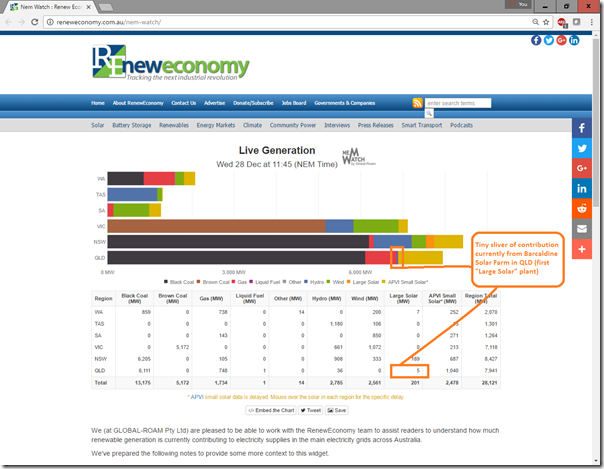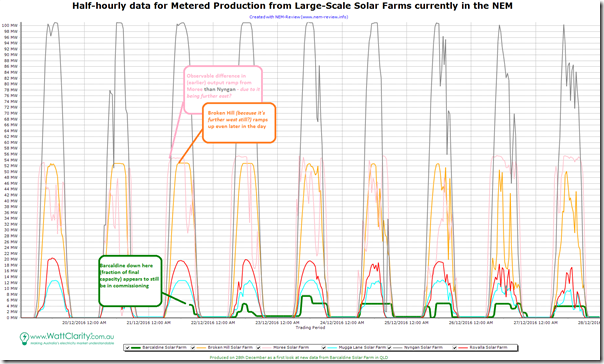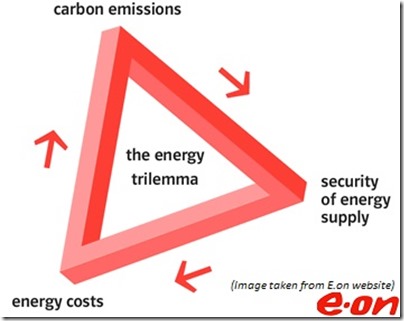In amongst the pre-Christmas madness last week, we missed the opportunity to post about the advent of a new data feed for the Barcaldine Solar Farm in Queensland – the first of what will end up being a large number of solar farms across the “Sunshine State” if the current Government’s audacious “50% by 2030” transformational plan comes to fruition.
1) About the Barcaldine Solar Farm
For those without a paid licence to one of our dashboard-style display products (like the full NEM-Watch or our higher-end tools) you are still able to keep an eye on the output of Barcaldine as part of the broader energy mix in the popular, RenewEconomy-sponsored NEM-Watch Fuel Type Widget, as illustrated here:
Currently Barcaldine is the (first and) only Large Scale Solar plant in QLD so the total output for the state will equate to what is produced for the Barcaldine plant.
However there are a number of others following on the heels of Barcaldine, so expect the total to be augmented by other projects through 2017 – where time permits, we’ll post about these on WattClarity.
Out of curiosity, we also generated this trend of half-hourly data using our NEM-Review analytical tool (new version coming in 2017) – we’ve highlighted the output from Barcaldine down the bottom of the chart:
Clearly the Barcaldine plant (maximum output to be 25MW) is still undergoing commissioning over the past week – we’ll expect to see its output ramp up over the coming weeks.
I’ve also noted how the outputs of the three big NSW Large Scale solar plant appear to be slightly staggered most days – which I presume is due to their location (east-to-west). Perhaps one of our more informed readers can confirm this for us?
2) About the current QLD Government’s audacious* 50% ambition
The current Queensland Government has announced an ambition to have 50% of electricity supplies coming from new renewable sources by 2030 – and in 2016 established the Queensland Renewable Energy Panel to consider how to achieve this. According to that website a final report was provided to the Government for some light Christmas reading, so we hope to hear more about that in early 2017.
* my dictionary has the definition of audacious as “showing a willingness to take surprisingly bold risks” and, in my mind, the current QLD 50% ambition is surely that.
That is not so say that it could not be achieved – however a key point is the word “risk”. It’s clear that there are risks involved (technical, political, commercial and otherwise), just as there are risks in not having such a plan (to do with climate change, ageing infrastructure, etc…).
Currently it seems that there has been too little emphasis placed on how these risks can be effectively managed. Now with the current vexed political climate (with a sizeable group of people at either end of the Emotion-o-meter, shouting at each other and drowning out more rational discourse) I can understand why the hesitation by openly considering the risks inherent in the transition. However surely to not do so and adopt a “she’ll be right, mate!” approach is just to make matters worse?
As shown in the snapshot of this morning’s energy mix in Queensland above, it’s a huge share of black (coal) and red (gas) that always makes up the lions share of the energy supply in Queensland. That’s not to diminish the substantial contribution coming from small scale solar (including my own 5kW rooftop power station at home) during sunny daytimes.
We should not be under any illusions about the challenges involved in getting there. A number of submissions to the draft report flagged some of these challenges – and I noted the “more work required” score given to the Draft Report by David Leitch on RenewEconomy here. David noted that:
“The report is successful politically in that the key conclusions are that prices won’t increase, no thermal generation has to close and system reliability isn’t compromised.”
For me, this was based on a rather “courageous” assumption that existing thermal plant would all stick around, despite having volumes collectively cut in half, to put a lid on prices and keep the system secure.
(a) This (i.e. that loss-making plant will choose to stay) seems to fly in the face of recent history:
i. in the Queensland region (such as with the mothballing of Tarong units, and now Swanbank E, in response to oversupply);
ii. more broadly across the NEM(with closure of Redbank, Wallerawang, Anglesea, Northern and other pre-existing thermal plant, including the looming closure of the big-ticket and much-hated Hazelwood plant); and
iii. in what’s happening internationally in many markets suffering from oversupply and an incentivised influx of lower-emissions plant.(b) Now the QLD government does have another ace up its sleeve – in that it does still own the bulk of the generation assets through the Government-Owned Corporations CS Energy and Stanwell. So it could presumably take the approach of instructing them to “run the assets into the ground”, but not actually close them (notwithstanding concerns of the “clapped out 2nd car” I have already spoken about).
i. Given that the privatisation boat has long since sailed for the generation assets in the Queensland government portfolio, successive (Beattie-Bligh-Newman-Palaszczuk) governments have all tacitly agreed to a reduced return from the generation assets under its control over 10 years or more. Hence, to some extent, the financial damage has already been done.
ii. However Queensland Treasury has already shown its unhappiness in the past of handing over cash to prop up loss-making, government-owned generation companies. Expect plenty more of that in the years to come to 2030 if they want to shoe-horn in more supply options to an increasingly oversupplied market and not allow plant to leave…
Recalling those infamous words of Peter Beattie when speaking prior to the sale of the Energex and Ergon retail arms (along the lines of “power prices won’t rise”) I do wonder if this is not another Minister setting themselves up for opprobrium – by seeming to simplistically claim that there are no trade-offs to be made in this energy transition:
Across the energy sector there are a large number of people openly acknowledging the challenges inherent in balancing the three legs on the stool that is the “Energy Trilemma” – image above taken from the E.On website here.
Surely, in 2017 we can have a More Mature Discussion of the challenges involved in such a transition (not solved yet, but solvable with rational discourse and less political slogans from both ends of the Emotion-o-meter)?
Will the final report of the Expert Panel contribute to this “more mature discussion” – or will it continue with the large degree of wishful thinking contained in the draft report …





Moree has single axle tracking while the Broken Hill and Nyngan plants have fixed panels. This might be the reason why Moree gets up and running before Nyngan does. It is also several hundred km north east of Nyngan
Can I suggest that a good step can be taken towards a More Mature Discussion by dropping the ubiquitous word “challenges”, and calling it for what it really is, problems, problems, problems.
Ironically Tasmania, only recently beset by a major problem, now looks like the best place to be for electricity consumers, because of its relative immunity to governments setting targets.
PS one of our shyer/shier readers has emailed in the following explanation:
Our thanks to them for that!